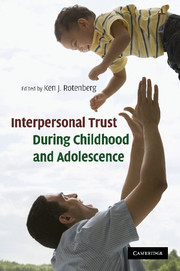Book contents
- Frontmatter
- Contents
- List of figures
- List of tables
- List of contributors
- Section I Conceptual foundations and issues
- Section II Childhood
- 5 Young children's trust in what other people say
- 6 Social relation and mutual influence analyses of children's interpersonal trust
- 7 Siblings and trust
- 8 The role of promises for children's trustworthiness and honesty
- 9 Liar liar! Pants on fire: Detecting the trustworthiness of children's statements
- Section III Adolescence and early adulthood
- Index
- References
8 - The role of promises for children's trustworthiness and honesty
Published online by Cambridge University Press: 04 August 2010
- Frontmatter
- Contents
- List of figures
- List of tables
- List of contributors
- Section I Conceptual foundations and issues
- Section II Childhood
- 5 Young children's trust in what other people say
- 6 Social relation and mutual influence analyses of children's interpersonal trust
- 7 Siblings and trust
- 8 The role of promises for children's trustworthiness and honesty
- 9 Liar liar! Pants on fire: Detecting the trustworthiness of children's statements
- Section III Adolescence and early adulthood
- Index
- References
Summary
The ability to keep promises is often considered a major hallmark of trustworthiness (Rotenberg, McDougall, Boulton, Vaillancourt, Fox, and Hymel, 2004; Talwar, Lee, Bala, and Lindsay, 2002). But what are promises? Why do we keep and break them, and what purpose do they serve? It is surprising that so little is known about such an everyday concept. Apart from their colloquial use, promises serve a vital role in the legal system. In criminal proceedings, witnesses are required to take a sworn oath which entails promising to tell the truth. In this context, it is believed that promises have an honesty-promoting effect. On the other hand, promises are not always used to promote honesty. At times, they are used to inhibit it. For example, perpetrators of child sexual abuse sometimes ask their victims to promise to keep the abuse secret. Adults ask children to keep secrets within the family, and children swear each other to secrecy. Children may witness a school friend damage property and be sworn to secrecy by their friend; they may swear each other to secrecy over a less serious matter, such as who they like best in their class; or they may swear the victims of bullying to secrecy.
It is apparent, therefore, that promises can serve different purposes in different situations. In some circumstances they can promote truth-telling and in others they can undermine it. How can promises serve such different purposes?
- Type
- Chapter
- Information
- Interpersonal Trust during Childhood and Adolescence , pp. 155 - 176Publisher: Cambridge University PressPrint publication year: 2010
References
- 3
- Cited by



